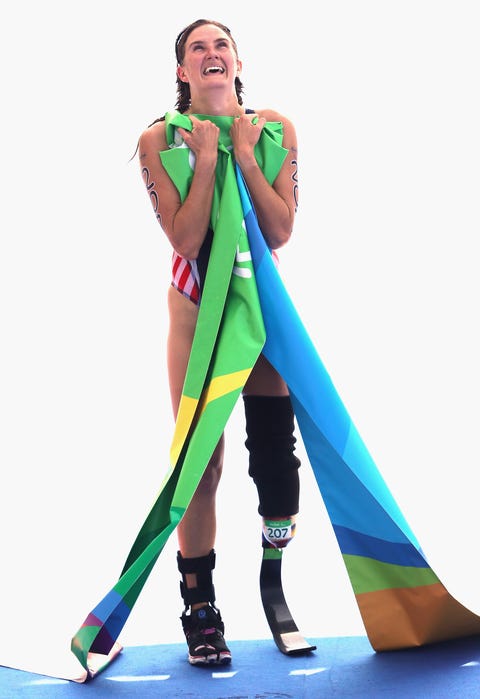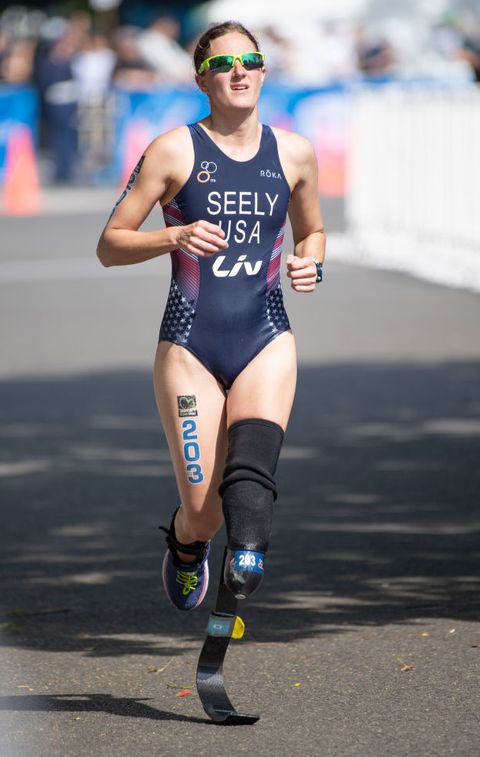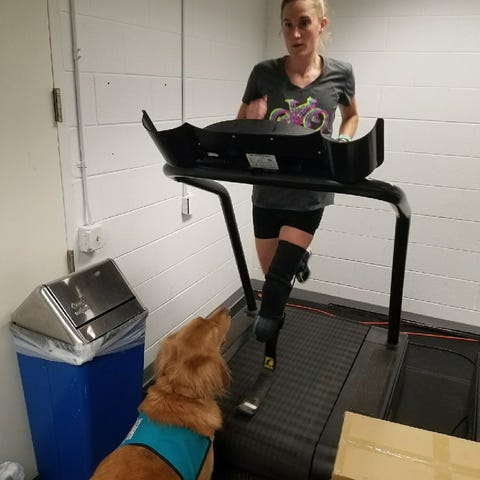Allysa Seely came home from the 2016 Rio Paralympics with a gold medal in triathlon and a place in the history books. It was the first time triathlon was included as
a medal event at the Paralympic Games and just three years after Seely's left leg was amputated below the knee, the result of several conditions that affect her brain and spine.
Now, just 100 days out from the start of the Tokyo Paralympics, the 32-year-old athlete opens up about preparing to defend her medal—and the invisible chronic illness that affects her every step of the way.
I remember nearly everything about that moment. It was Sept. 11, 2016, and I was competing in the very first Paralympic triathlon. I was running the finishing chute, and my younger brother was sprinting alongside the barricades. He was tripping and pushing people out of the way, screaming at the top of his lungs. He was yelling and cheering, telling me I did it: I won gold.
Before the Games, I told myself I’d only compete once. The amount of energy you pour into the Paralympics is unbelievable, and I really thought when I crossed the finish line, I’d be done. But as soon as I actually did, I knew it wasn’t over. I wanted to defend my medal in Tokyo.

Idid my very first triathlon in 2008 and immediately fell in love. But not long after, I started having neurological symptoms. It started with dizziness, headaches, some passing out, and then progressed to partial paralysis, spasticity in my muscles, chronic pain, and seizures. It took about two years to get a diagnosis [of Chiari II malformation, basilar invagination, and Ehlers-Danlos Syndrome], and I had surgery on my brain and spine. Afterwards, I was determined to reclaim my life. During those two years, I hadn’t been living; I was just surviving. I had a hard time finding joy because I was in so much pain.
Coming out of that surgery, I never imagined competing at the highest level. But I started learning how to run again, how to bike and swim. Eight months after my surgery, I completed in the Collegiate National Championships as the first person with a disability to do so. I was much closer to last place than I was used to, but I realized I could keep chasing my dream of being an elite athlete.
It took away the pain and the uncertainty. Becoming an amputee allowed me to continue on.
By 2012, I was competing at the ITU Paratriathlon World Championships. We also learned triathlon would be in the 2016 Paralympics for the first time, and I made it my goal to be there. Unfortunately, I continued to have lasting neurological deficits, which really affected my left foot and leg. In 2013, after meetings with about eight surgeons, we decided it was best to amputate my leg below the knee.
About four weeks later, I was walking again. Eight weeks later, I started to run. Having a prosthetic foot ended up being way more functional than the foot I had before. It took away the pain and the uncertainty. Becoming an amputee allowed me to continue on.
Ijoke that for everybody else, the chaos in 2020 started in March, but for me it started in January. I got an infection in my leg and ended up having surgery. I was on crutches for four weeks, meaning I missed a month of training leading up to the original Tokyo selection event in March. It was devastating. When I got back to training, it took less than a week before I found out I had another infection. I needed surgery and wasn’t supposed to get my stitches out until two days after the qualifying event. I begged to the surgeon, “You have to take these out a few days early. I don't care if you take them out the morning of the race. I don't care if I have no training. I'm going to figure out how to race.”

He agreed and took the stitches out a few days before the race in Florida. I got all the way there, and I still wasn’t allowed to walk. I wasn't going to be allowed to put the prosthetic on until the day before the event. I was trying my best to convince myself I was ready.
Then at about 2 a.m. the day before the race, it got canceled due to the pandemic. It was definitely a hallelujah moment—and also the beginning of something we never could have imagined. Soon after, we got word the Olympics and Paralympics were being postponed. I thought, What’s next? How do we refocus and look forward?
I started to train again, and in July, I went to the emergency room with an infection in my bloodstream. That started the next wild ride: Over the following few months, I had intermittent fevers as high as 105 degrees. I was exhausted all the time. In October, I was diagnosed with endocarditis, a serious infection in your heart, as well as an infection in my bloodstream, both of which could be lethal. At one point, I had a life-threatening immune response to antibiotics and spent an extended amount of time in the ICU and the hospital. I spent about six months away from home, away from training, away from feeling like myself. I started training for Tokyo again this February, but I’m still having symptoms, including the fevers, pain, body aches, rashes.
In all honesty, it’s made my training brutal. We have to make decisions day by day, but I’m trying not to lose sight of my goal and how to get there. In the big picture, I still absolutely plan on being in Tokyo. But in small moments, it’s hard to remember why I’m doing this.


Being a high-level athlete with a chronic illness, I encounter two types of doctors: Those that think I’m too sick to be doing what I’m doing, and those that think I’m not as sick as I say I am because of what I’m doing. This past summer, when I thought I had a serious infection, I was discharged from a hospital because I “looked too good” to have one. People kept saying the bloodwork must be contaminated because there’s no way I could be that sick and still get up and go to practice. Nobody believed I could be as sick as I said I was until it almost killed me. Women are more likely to experience chronic illness, and they're less likely to be believed by the medical community. But everybody handles illness differently. If I tell you something is wrong, the least you can do is believe me.
Nobody believed I could be as sick as I said I was until it almost killed me.
Everybody naturally judges my prosthetic leg and sees that as my disability. But in reality, my primary disability is my congenital brain malformation, and the amputation was a result of that. My prosthetic works better than the foot I had; it’s how I can still have an active lifestyle. Everything else I deal with is invisible to people who don’t know me well. It’s something I've always kept very close to my heart. I didn’t tell people these challenges, the struggles of having a complex chronic illness, but recently I’ve realized that hiding that huge part of my life was doing a disservice to myself and others in similar situations. A lot of times, people with chronic illnesses are seen as too sick to have a fulfilling life. That’s just not true. Exercise is my ticket to freedom.
Learn more about the Paralympic hopefuls here. The Tokyo Paralympics begin Aug. 24 on NBC.
This interview has been edited and condensed for clarity.
